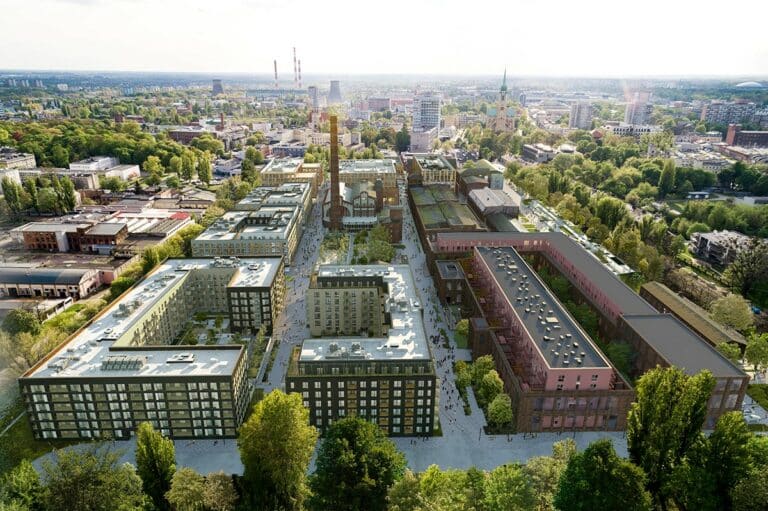Polish Real Estate Investment in 2024. A Record Year od Diverse Deals
Investment Activity Sees Remarkable Growth
Poland’s commercial real estate market witnessed a significant surge in investment activity in 2024, with transaction volumes reaching over EUR 4.8 billion across more than 120 deals, according to the latest Savills Poland report, ‘Investment Market in Poland in 2024’. This represents a 136% increase in transaction volume compared to the previous year and a transaction count more than 1.5 times higher. While this figure aligns with the average annual volume recorded between 2015 and 2017 (EUR 4.6 billion), it remains nearly 30% lower than the peak investment years of 2018–2022.
Sector-Wide Investment Trends
Investment transactions spanned all sectors, including hotels, student housing (PBSA), and build-to-rent (BtR or PRS) apartments. The office and retail sectors commanded nearly equal shares of investment, at 34.4% and 33.9%, respectively, largely driven by three major retail transactions totaling EUR 1.063 billion. The industrial sector accounted for over 26% of the total volume. Notably, the industrial and warehouse market slipped to third place in transaction volume in 2024, yet its share has grown over the past decade—from under 20% between 2015 and 2019 to nearly 40% in the last five years. This expansion has come at the expense of the retail sector, which declined from 37% to 21%, and the office sector, which dropped from 39% to 32%, as detailed in Savills Poland’s analysis.
Key Transactions and Investor Activity
The surge in 2024 investment volume was primarily driven by high activity in the second half of the year, particularly in the fourth quarter, which accounted for 48% of total transactions.
Among the largest deals in 2024 were the sale of a 49% stake in CPI to Sona Asset Management in the second quarter, followed by the acquisition of Silesia Shopping Centre in Katowice for EUR 405 million and Magnolia Park in Wrocław for EUR 373 million by Nepi Rockcastle in the fourth quarter. Domestic buyers contributed approximately 10% of acquisitions, totaling EUR 0.5 billion across more than 40 deals, including office buildings acquired by public institutions. Investors from Central and Eastern European countries, including Ukraine and the Baltics, represented 19% of the volume, while South African investors accounted for over 20%, as highlighted in Savills Poland’s market insights.
Notably, 2024 saw several first-time investors entering the Polish market. Emira Property Fund from South Africa acquired a 25% stake in DL Invest, Sona Asset Management from the UK invested in CPI Property Group with a 49% stake, and Estonia’s Summus Capital acquired two office buildings.
Office Market: A Year of Recovery
The office sector recorded nearly 45 deals valued at over EUR 1.64 billion, marking a fourfold increase from the previous year. While Warsaw dominated office transactions, significant investor activity was also noted in regional hubs such as Gdańsk, Katowice, Kraków, Łódź, Poznań, Szczecin, and Wrocław. Some office acquisitions were made for owner-occupation, including three buildings acquired by public institutions. Additionally, several assets, such as Curtis Plaza and myhive Mokotów, were purchased for redevelopment into residential properties, a trend expected to continue in the coming years. Savills Poland reports that prime office yields in central Warsaw remained stable at around 6.00%, with regional cities offering a 125–150 basis point premium.
Retail Sector: Major Transactions and Market Shift
The retail sector saw an investment volume exceeding EUR 1.6 billion, with three major deals accounting for over EUR 1 billion. These included Silesia Shopping Centre for EUR 405 million, Magnolia Park for EUR 373 million, and a six-property shopping center portfolio sold to Star Capital Finance for EUR 285 million. Despite strong shopping center deals, investors are increasingly focusing on smaller retail projects, particularly retail parks and convenience centers, which have demonstrated faster growth and resilience. Savills Poland’s analysis indicates that prime retail yields in Poland were estimated at 6.25–6.50%, with Magnolia Park and Silesia City Centre yielding 6.70% and 7.5%, respectively. Retail park yields ranged from 7–8%, depending on location and tenant composition.
Industrial and Warehouse Market: Strong but Facing Adjustments
The warehouse and industrial sector recorded nearly 30 transactions in 2024, totaling EUR 1.26 billion, reflecting a 27% increase over 2023. However, the sector dropped to third place in investment volume, having led the market the previous year. Looking ahead, a significant boost is expected in 2025, particularly with Ares Management Corporation’s acquisition of GLP Capital Partners Limited’s international business. Savills Poland notes that yields stabilized at 6.25–6.50% throughout 2024, with the lowest yield of 6.15% recorded in the sale of City Logistics Warsaw IV.
Living Sector: Student Housing and BtR Expansion
Investment in the living sector totaled EUR 141 million, with 20% allocated to the sale of LivinnX Kraków (now Basecamp) to Xior Student Housing. Other notable deals included the acquisition of Siennicka 29A in Warsaw by Van der Vorm Vastgoed, the purchase of the City Living Portfolio in three cities by undisclosed buyers, and the sale of Wrocławska 53J in Kraków by G City to Lew Invest. A forward funding deal was completed for Ostrobramska 86 in Warsaw, which will join Griffin Capital Partners’ LifeSpot portfolio. In January 2025, Xior Student Housing announced two more PBSA acquisitions in Warsaw and Wrocław, valued at EUR 67 million. According to Savills Poland, prime yields for student housing assets stand at approximately 6.00%, while BtR projects yield around 5.50% on residential-zoned sites.
2025 Outlook: Market Optimism and Key Trends
Investor confidence is rebounding, driven by value-add opportunities and better pricing conditions. European open-ended funds, under pressure to meet redemption requests, are divesting assets, increasing transaction volume. Institutional investors are also returning, lured by favorable financing conditions. Lower borrowing costs will likely fuel more transactions in prime assets, as institutional investors view them as secure long-term investments.
Domestic and Central and Eastern European investors played a crucial role in 2024. While Polish investors targeted mid-sized properties in secondary cities, CEE investors focused on larger high-yield assets. Savills Poland anticipates that this trend will continue in 2025, with favorable financing conditions boosting cross-border investments. As Poland’s commercial real estate market enters 2025, the sector stands on strong footing, with greater investor diversity, increasing deal flow, and favorable macroeconomic trends set to sustain the positive momentum.







